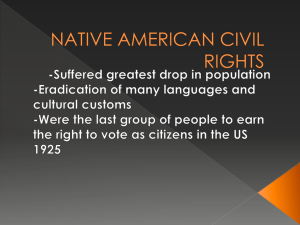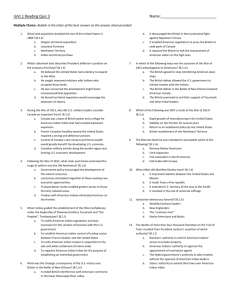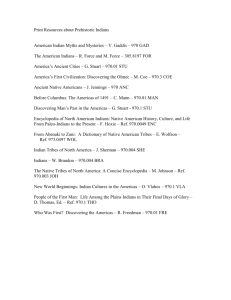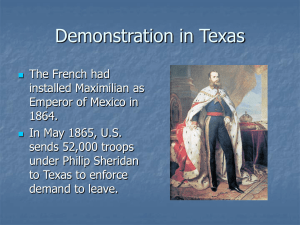American Indians in the 20th Century: Issues and Debates
advertisement
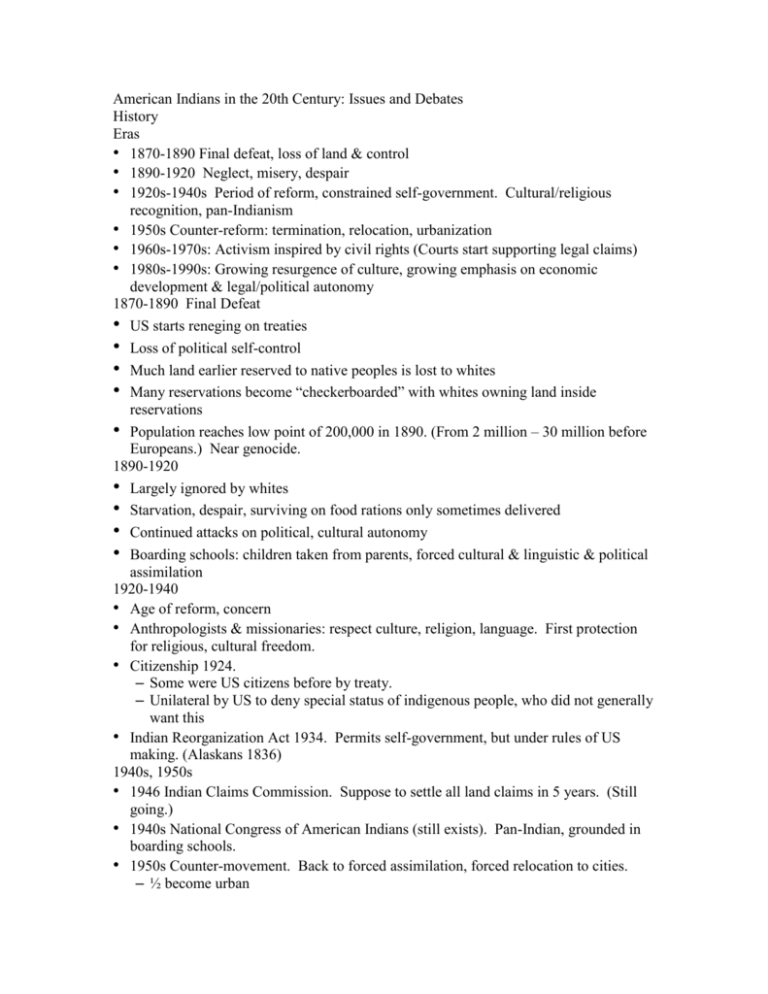
American Indians in the 20th Century: Issues and Debates History Eras • 1870-1890 Final defeat, loss of land & control • 1890-1920 Neglect, misery, despair • 1920s-1940s Period of reform, constrained self-government. Cultural/religious recognition, pan-Indianism • 1950s Counter-reform: termination, relocation, urbanization • 1960s-1970s: Activism inspired by civil rights (Courts start supporting legal claims) • 1980s-1990s: Growing resurgence of culture, growing emphasis on economic development & legal/political autonomy 1870-1890 Final Defeat • US starts reneging on treaties • Loss of political self-control • Much land earlier reserved to native peoples is lost to whites • Many reservations become “checkerboarded” with whites owning land inside reservations • Population reaches low point of 200,000 in 1890. (From 2 million – 30 million before Europeans.) Near genocide. 1890-1920 • Largely ignored by whites • Starvation, despair, surviving on food rations only sometimes delivered • Continued attacks on political, cultural autonomy • Boarding schools: children taken from parents, forced cultural & linguistic & political assimilation 1920-1940 • Age of reform, concern • Anthropologists & missionaries: respect culture, religion, language. First protection for religious, cultural freedom. • Citizenship 1924. – Some were US citizens before by treaty. – Unilateral by US to deny special status of indigenous people, who did not generally want this • Indian Reorganization Act 1934. Permits self-government, but under rules of US making. (Alaskans 1836) 1940s, 1950s • 1946 Indian Claims Commission. Suppose to settle all land claims in 5 years. (Still going.) • 1940s National Congress of American Indians (still exists). Pan-Indian, grounded in boarding schools. • 1950s Counter-movement. Back to forced assimilation, forced relocation to cities. – ½ become urban • Boarding schools, forced adoptions continue • Termination = cancel treaties, force people to be legally like everyone else. Attacks on self-determination using the language of equality & liberation. 1960s-1970s • Inspired by Civil Rights Movement, renewed activism • Disruptive protests, occupations • Militant exercise of treaty rights – Fish-ins etc. Militant exercise of treaty rights as a protest. – Occupation of Alcatraz Island 1969-1972 – Trail of broken treaties • Development of Indian legal defense teams • Assertions of nationhood, cultural autonomy • Urban Indians & reservation Indians interact. Trail of Broken Treaties 1972 demands • Recognition of sovereignty • New treaties and enforcement of old • Increase land base of native people • Funds for economic and educational development Alcatraz Proclamation (1969) - excerpts To the Great White Father and his People We, the native Americans, reclaim the land known as Alcatraz Island in the name of all American Indians by right of discovery. We wish to be fair and honorable in our dealings with the Caucasian inhabitants of this land, and hereby offer the following treaty: We will purchase said Alcatraz Island for twenty-four dollars in glass beads and red cloth, a precedent set by the white man’s purchase of a similar island 300 years ago. We know that $24 in trade goods for these 16 acres is more than what was paid when Manhattan Island was sold, but we know that land values have risen over the years. Our offer of $1.24 per acre is greater than the $0.47 per acre the white men are now paying the California Indians for their lands. We will give to the inhabitants of this island a portion of the land of their own to be held in trust . . . by the Bureau of Caucasian Affairs . . . in perpetuity -- for as long as the sun shall rise and the rivers go down in the sea. We will further guide the inhabitants in the proper way of living. We will offer them our religion, our education, our way of life -- ways in order to help them achieve our level of civilization and thus raise them and all their white brothers up from their savage and unhappy state. We offer this treaty in good faith and wish to be fair and honorable in our dealings with all white men. Alcatraz Proclamation, more excerpts We feel that this so-called Alcatraz Island is more than suitable for an Indian reservation, as determined by the white man’s own standards. By this, we mean that this place resembles most Indian reservations in that: •It is isolated from modern facilities, and without adequate means of transportation. •It has no fresh running water. •It has inadequate sanitation facilities. •There are no oil or mineral rights. •There is no industry and so unemployment is very great. •There are no health-care facilities. •The soil is rocky and nonproductive, and the land does not support game. •There are no educational facilities. •The population has always exceeded the land base. •The population has always been held as prisoners and kept dependent upon others. Alaskans • Similar patterns in Alaska, but less White settlement, not forced into reservations • Alaska oil pipeline: settlement creates corporations of native people who will own some of the rights. • 1971 Alaska Native Claims Settlement Act • Alaskan people able to benefit from some of the lessons of those in the “lower 48” Alaskan regional corporations 1980s –2000s • Growing cultural revitalization – powwows, etc. – Specific tribal culture & language – Pan-Indian movements, cooperation • Growing emphasis on economic development on the reservation so a separate life can be viable • Continuing legal actions to defend treaty rights, press land claims & political sovereignty • Emphasis on separateness, distinctiveness of indigenous people. “We are still here.” “We are still here” • American Indian Movement • Native American Rights Fund • National Congress of American Indians • Economic development organizations • Pow-wows, spirituality FAQs about AmerInds Saved copy of HTML version of BIA FAQ file Basic Issues/Conflicts Pan-Indianism • Emphasis on own tribe/culture – Teach the language; bilingual instruction – May be hostility/conflicts with other tribes vs • Emphasis on commonalities as “indigenous peoples” – National Congress of American Indians – American Indian Movement – Ties with indigenous people in other countries • Many do both Legal status ● acknowledging and valuing special culture, history, legal status VERSUS ● treating everybody "the same," getting rid of American Indians as a distinct cultural/legal group What is culturally/politically important about "Indians“? Economic development • "White": Indians have to join the 21st century: Close down the reservations, move to cities, assimilate, become culturally White. • "American Indian": Need to do economic development on the reservations, create ways of making a living that keep the people together, preserve cultural values. Tribes Developing Successfully • Have effective tribal autonomy (decisions are made by local tribe, not BIA) • Have effective government that can enforce contracts & maintain order • Have governmental forms that fit the culture (either parallel governments used before conquest or are adaptive to new circumstances – not imposed IRA forms) • Are teaching children & adults their native language, running their own schools, & expanding their own cultural practices • http://www.ksg.harvard.edu/hpaied/res_main.htm Land conflicts • "White": land is to be used, it is unfair to keep whites out of any section of land. Current possession or occupancy should outweigh any historical legal claims. (Some occupants have a multi-generational sense of entitlement, of belonging to the land through parents or grandparents, occasionally further generations.) No recognition of group or tribal ownership. • "American Indian": We belong to the land, the land does not belong to us. Land, place is sacred. Religion closely linked to place. Ancient ancestral claims are still valid, current users/occupants are squatters who should be evicted. Political conflicts • Legal institutions recognized by US government, BIA. Rules require recognition of "mixed bloods" up to 1/4 "Indian" ancestry, require certain voting rules, certain governmental forms. Tend to be dominated by the more assimilated or mixed elements. • "Traditional" rules, standards of government, self-rule. Traditionals may reject "official" government as legitimate. • Ongoing conflict is common on many reservations. Social Issues • Alcohol, in many cases. (Varies by group) • Poverty. • Culture, meaning. • Lifestyle disputes. E.g. structured, clock-based, accumulation-oriented “American" lifestyle oriented to "getting ahead." Vs. unstructured, eat when you are hungry, go to bed when you are tired, work when you need money or food, spend a lot of time socializing. Cultural Issues • Use of “Indian lore” by non-Indian youth groups, adoption of “Native American spirituality” by non-Indians are seen as respectful by the non-Indians who do it, seen as insulting by many (not all) AmerIndians. (Comparable to a non-Christian wearing a crucifix, making a Jesus doll, or putting on a Communion ceremony.) • Bilingual education, renewed emphasis on teaching native languages, reinvigorating “traditional” culture. • Inter-mixing of Pan-Indian and tribal cultural elements. Culture as preserving relics vs. culture as always evolving. Gaming: legal • American Indian reservations have a legal status roughly comparable to US states: self-governing sovereign political units under US government • Courts in 1970s, 1980s ruled that if gambling was a crime in a state, Indians could not do it, but if only civilly regulated, they could. • 1988 Indian Gaming Regulatory Act requires that gaming revenues can be used only for charitable or governmental purpose • Later amendments require negotiation so tribes must share revenue with states • www.indiangaming.org [pro-gaming site] Gaming: economic • Only ~5% of tribes have had significant economic gain from gaming • Experiences have varied, but the tribes generally use the money for social services, housing, education, investing in other economic-development activities; has been a significant benefit to some tribes • Controversies within tribes about costs vs. benefits • The profitability is tied to monopoly, which is ENTIRELY under the control of Whites, who can legalize casinos for Whites any time they want to • Controversial & conflicting studies about economic impacts of casinos on the surrounding White communities Treaty Rights • Are property rights arising from contracts. • Belong to tribes, not individuals; apply to specific parcels of land involved in a contract. • E.g. Chippewa hunting & fishing rights. • Like the mining rights that some companies buy from landowners or retain when they sell land. • Some activists calling for new treaties or more extensive enforcement of old treaties Chippewa Cessions Wisconsin Reservations Hopi-Navajo Conflict • Competing claims on land by different tribes • Product of the resettlements of the 19th century Arizona Tribes New Mexico Maps US Reservations in the 20th Century Open PDF file reservationmapUSwhole.pdf Indian Nations pre-European Calif pre contact Calif Treaties California 1997 Indian Nations, SE 1820 Oklahoma 1890 North Dakota South Dakota
